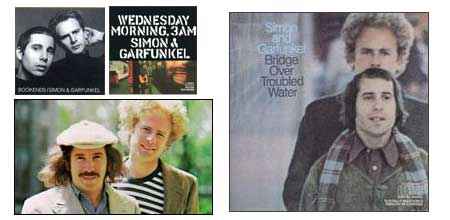Simon & Garfunkel

Synopsis of Pop Music
“I’m on your side, when times get rough,
And friends just can’t be found,
Like a bridge over troubled water,
I will lay me down…”
Two guys, one guitar, millions of records sold: That’s Simon & Garfunkel in eight words. Paul Simon was the man behind the guitar (and nearly all of the songwriting), while Art Garfunkel balanced Simon’s voice with a high tenor that could soothe the most savage beast on the planet. Together, the two made some of the most beautiful and beloved music of the late 1960’s, carrying the folk revival to the top of the charts for one catchy, thought-provoking single after another.
Paul Simon and Art Garfunkel met during their junior high school days in New York, and they began recording together while still in their early teens. In 1957, the sixteen-year-old duo earned a one-song record deal with Big Records on the strength of a Paul Simon-penned demo. The demo song, “Hey Schoolgirl,” was released that same year, with Simon & Garfunkel being given the stage names Tom (Art) & Jerry (Paul). A performance on American Bandstand pushed the single nearly into the Top-40, but Tom & Jerry’s recording career stalled after their initial success.
Simon & Garfunkel went their separate ways for a while after high school, as Art pursued his higher education and Paul continued to write and perform solo and with a few bands. But by the early 1960’s, the two were back together, now performing under their own names. Simon’s folk-styled compositions began to attract label attention as the genre moved into the pop mainstream, and in 1964, Simon & Garfunkel recorded their first album for Columbia Records, titled Wednesday Morning, 3 AM.
The album was a commercial disappointment, and Simon returned to Britain, where he had been performing on the folk circuit for years. But a funny thing happened on the way back to obscurity… Columbia executive Tom Wilson took one of Simon & Garfunkel’s tunes, remixed it with added instrumentation, and released it to the public without the knowledge of the two performers. The song was “The Sounds of Silence,” and the remixed version hit #1 on the pop charts at the beginning of 1966.
Paul Simon returned to the States, re-teaming with his vocal partner on an album’s worth of new material. Wednesday Morning, 3 AM finally entered the U.S. charts, but it was outshined by its follow-up, The Sounds of Silence. The new album, which contained the remixed “Sounds of Silence,” added further Top-10 hits in “Homeward Bound” and “I Am a Rock.” By the end of 1966, Simon & Garfunkel had yet another album, Parsley, Sage, Rosemary and Thyme, featuring continued hit singles in “The Dangling Conversation,” “Hazy Shade of Winter,” and the duo’s arrangement of the traditional “Scarborough Fair/Canticle.” The latter song wasn’t originally released as a single, but popular demand brought it out on 45 in the wake of Simon & Garfunkel’s next successful venture: the soundtrack to the seminal 1967 film The Graduate.
Simon & Garfunkel contributed several songs to The Graduate, but only one specifically composed for the film: “Mrs. Robinson.” Despite the song’s bleak lyrics about a generation that had lost its heroes, “Mrs. Robinson” was an enormous hit, spending three weeks at #1 and winning the duo a pair of Grammys (the complete soundtrack earned them a third that same year). Simon & Garfunkel continued their string of phenomenal success in 1968 with Bookends, an album that repackaged past favorites and added a few new ones like “America” and “Old Friends.”
With a straightforward blend of earnestly thoughtful lyrics and divine harmonies, Simon & Garfunkel had managed to win over both the critics and the casual listeners, but their greatest success wouldn’t arrive until their final studio album as a tandem. 1970’s Bridge Over Troubled Water was immediately hailed as a masterpiece, earning superlatives from the press and convincing a nation of teenyboppers to tear themselves away from their Archies and Jackson 5 records to sample something in a softer mood. The Latin-flavored “Cecilia” still gave them something to dance to, but the album’s centerpiece was its title song, a friendship ballad masterfully sung by Garfunkel, which went to #1 on both sides of the Atlantic (and at the same time, to boot). “El Condor Pasa (If I Could)” and “The Boxer” helped propel the album to multi-platinum status, remaining at the #1 spot on the U.S. charts for 10 weeks (and for 13 weeks on the U.K. charts) and earning yet another armload of Grammys.
Ironically, Simon & Garfunkel’s relationship was dissolving at the same time they were recording lines like “If you need a friend, I’m sailing right behind.” The two went their separate ways—Simon to solo work, Garfunkel to acting (although both men eventually did both). Simon & Garfunkel teamed up several times in the ensuing years—most notably for the #9 single “My Little Town” in 1975 and for a free concert in Central Park that eventually became a double-live album—but the reunions were always brief.
Both Simon and Garfunkel continue to record albums (including Simon’s highly-praised Graceland and Rhythm of the Saints), but the Simon & Garfunkel ampersand isn’t likely to be reinstated any time soon. Their legacy as a duo, however, remains intact, and their songs still inspire countless would-be troubadours and balladeers to team up, grab a guitar, and hope for lightning in a bottle.
Artist Release History
1964 - Wednesday Morning, 3AM1966 - The Sounds of Silence
1966 - Parsley, Sage, Rosemary and Thyme
1968 - The Graduate
1968 - Bookends
1970 - Bridge Over Troubled Water
1972 - Greatest Hits
1981 - Collected Works
1982 - Concert in Central Park
1997 - Old Friends
1999 - The Best of Simon & Garfunkel
Pop Sub Categories
popother
Essential Music Albums
Bridge Over Troubled Water (Columbia)The Best of Simon & Garfunkel (Sony)
Band Members
Paul Simon vocals, guitarArt Garfunkel vocals
